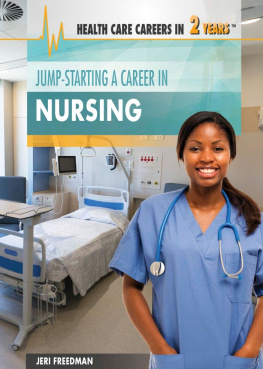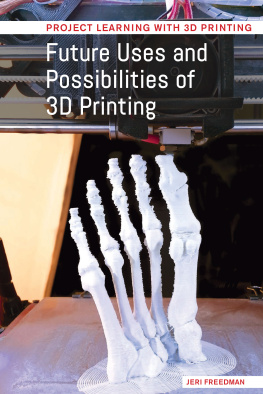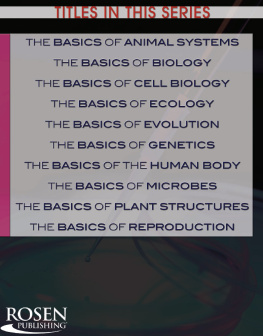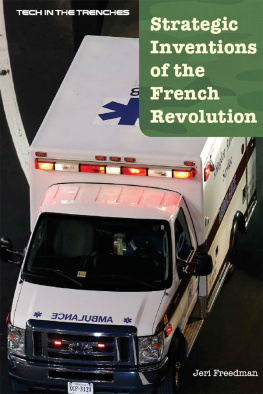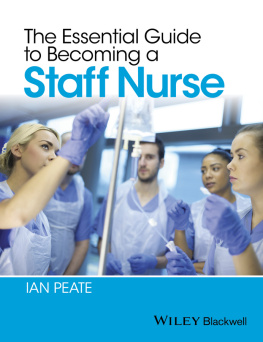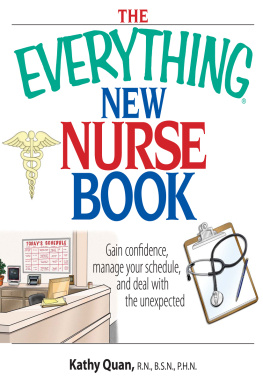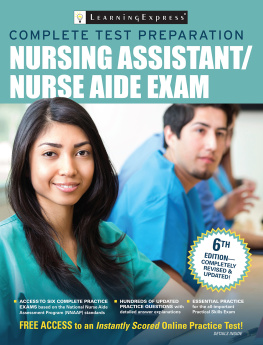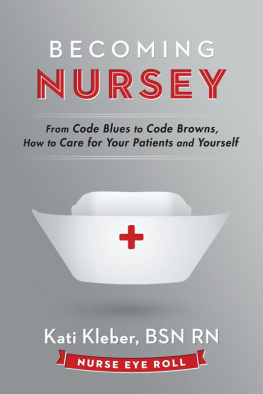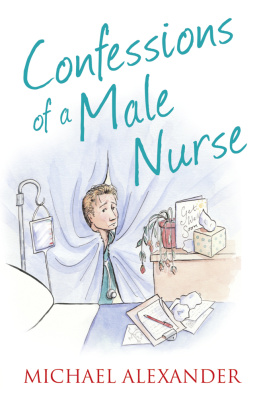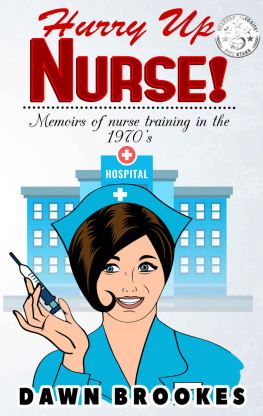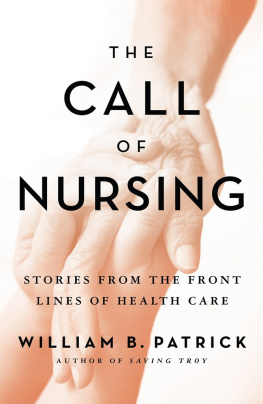Published in 2019 by The Rosen Publishing Group, Inc.
29 East 21st Street, New York, NY 10010
Copyright 2019 by The Rosen Publishing Group, Inc.
First Edition
All rights reserved. No part of this book may be reproduced in any form without permission in writing from the publisher, except by a reviewer.
Library of Congress Cataloging-in-Publication Data
Names: Freedman, Jeri, author.
Title: Jump-starting a career in nursing / Jeri Freedman.
Description: First edition. | New York: Rosen YA, 2019. | Series: Health care careers in 2 years | Includes bibliographical references and index. | Audience: Grades 7-12.
Identifiers: LCCN 2018008456| ISBN 9781508185024 (library bound) | ISBN 9781508185017 (pbk.)
Subjects: LCSH: Nursing-Vocational guidanceJuvenile literature. | NursesJuvenile literature.
Classification: LCC RT82 .F72 2019 | DDC 610.7306/9dc23 LC record available at https://lccn.loc.gov/2018008456
Manufactured in the United States of America
CHAPTER 1
THE HEALTH CARE FIELD
CHAPTER 2
GENERAL NURSING JOBS
CHAPTER 3
SPECIALTY NURSES
CHAPTER 4
EDUCATION FOR NURSING JOBS
CHAPTER 5
LANDING A JOB
CHAPTER 6
PROFESSIONAL DEVELOPMENT AND ADVANCEMENT
O n NurseCode.com, Jessica shared her experience as a new registered nurse (RN) on the job. The charge nurse introduced her to another nurse, Danielle, who would be showing her the ropes. Danielle juggled multiple things at the same time, evaluating patients, collecting medications, and answering the phone. She received notification that a patient was returning from knee-replacement surgery. Jessica helped Danielle shift the patient from the gurney to the bed, then Danielle got a phone call, and Jessica was left alone with the patient. She checked the patient's drainage line. Then she questioned him about his pain level and showed him how to use the morphine pump to get pain medication. It felt amazingshe was a real nurse.
Danielle returned and asked if Jessica wanted to hang an IV bag of antibiotic medication. With Danielle watching, she took the medication to the room, explained to the patient that she would be giving her an antibiotic, and checked for allergies. She prepared and attached the antibiotic bag and programmed the pump that would infuse the medication then turned it on. Noticing Danielle staring at the machine, she realized she hadn't released the clamp that would allow the medication into the machine. Embarrassed, she fixed her mistake.

She found the environment chaoticalarms were ringing nonstop and the corridor was filled with people pushing meal carts and equipment like X-ray machines. She was tired by later that afternoon when she returned to the room of the postoperative knee patient to check on him. His wife was visiting. Smiling, she said, "Are you Jessica? My husband said you are such a nice nurse and really helped him. Thank you." Jessica suddenly didn't feel tired anymore; she felt goodshe had made a difference.
Nursing offers an excellent career for individuals seeking a job that requires two years or fewer of training. There is a constant demand for employees in the health care field, so working in this industry can provide job security in good times and bad. While the work is demanding, it can also be fulfilling to help people who need you. Many people believe that careers in health care require extensive education, which is too expensive for many to consider them. However, there are many entry-level jobs in nursing that require two years or less of education or on-the-job training to get started. These jobs can be the first step on a solid career path. For example, one can become a nurse's aide with only on-the-job training. Other jobs, such as certified nursing assistant, require taking a training course that lasts for several months to one year and passing an examination. Still others, such as entry-level registered nurse, are obtainable with a two-year associate's degree.
The material here explains the jobs, facilities, and tools used in various types of entry-level nursing jobs. The training and certification required for each type of job will be covered. The nursing field provides good pay and the satisfaction of making a difference in the lives of others.
A variety of nursing jobs that require two years or fewer of instruction are available in health care. Nurses work in many types of facilities and specialize in different areas. The health care industry is growing, and the number of jobs is likely to continue to grow well into the future.
The Health Care Industry Today
The health care industry currently relies on nurses at all levelsfrom nursing assistants to registered nurses to nurse practitionersto a greater degree than at any time in the past. One factor that affects the provision of health care is that the number of elderly people in the population is continuing to grow. According to the US Census Bureau, the number of people in the United States over one hundred years old was 32,194 in 1980. A 2014 report by the US Centers for Disease Control and Prevention indicated that there were 72,197 Americans aged one hundred or older, an increase of 125 percent since 1980 and 44 percent since 2000, when there were 50,281 centenarians. Better vaccines, medications, antibiotics, hygiene, and sanitation have all contributed to the number of people living to advanced ages. In addition, people have become more aware of and interested in eating healthy food and staying active. The US Social Security Administration projects that Americans' lifespan will continue to increase throughout the twenty-first century. This prospect means that there will be more people alive at the same time than ever before. Since elderly people require more health services than younger people, this increases demand. At the same time, people are living longer.
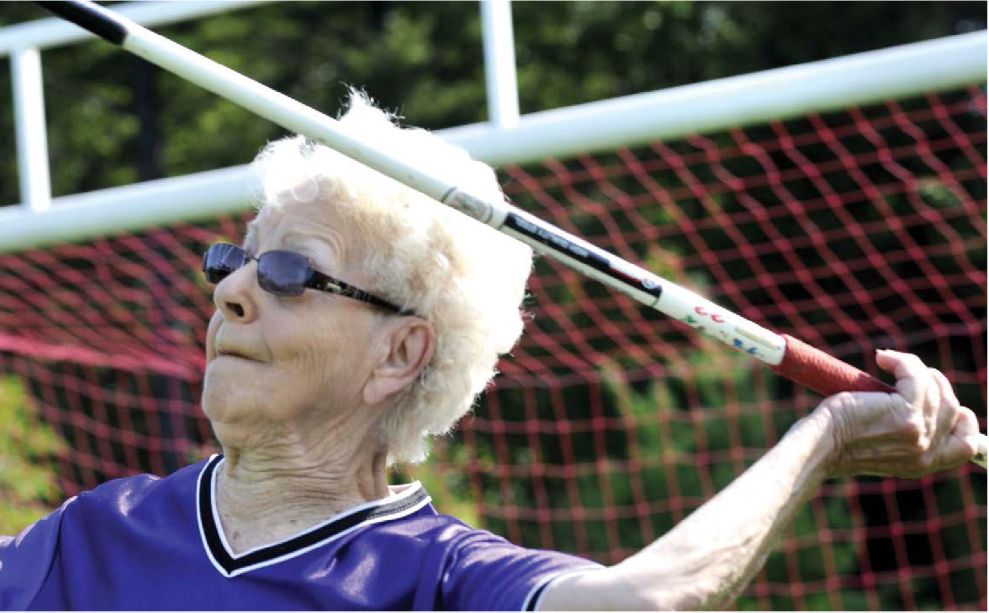
Increasingly people are engaging in sports in their eighties and beyond. They are also living longer than previous generations, which leads to a greater demand for health care services.
The Affordable Care Act, also called Obamacare, passed in 2010, and vastly increased the number of people covered by insurance. Although the Trump administration in 2017 repealed the requirement for people to have health insurance, that merely affects people who believe they are healthy enough to go without health insurance, according to many health experts. There are still more people who have coverage and who use health care services. In the past, people who could not afford health insurance rarely sought health care services unless they had medical crises, and then they went to the emergency room at their local hospital. There were some community health service clinics in the past, but the growing number of people without a regular doctor who need treatment for routine ailments has resulted in the proliferation of walk-in and "urgent care" clinics in the past two decades. The growth in the number of clinics creates a demand for more medical staff, including nurses.

